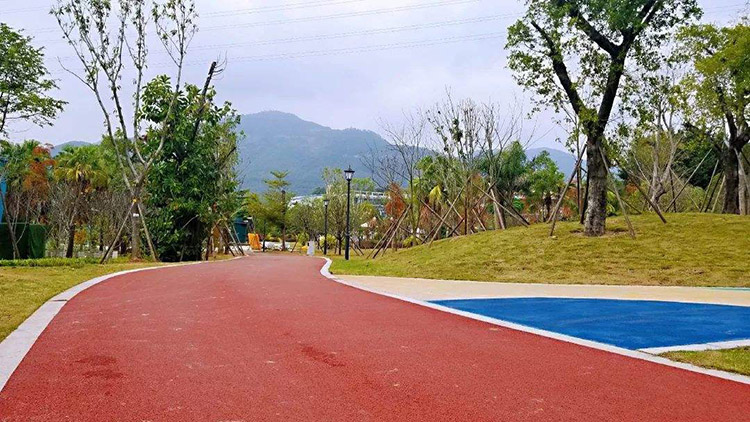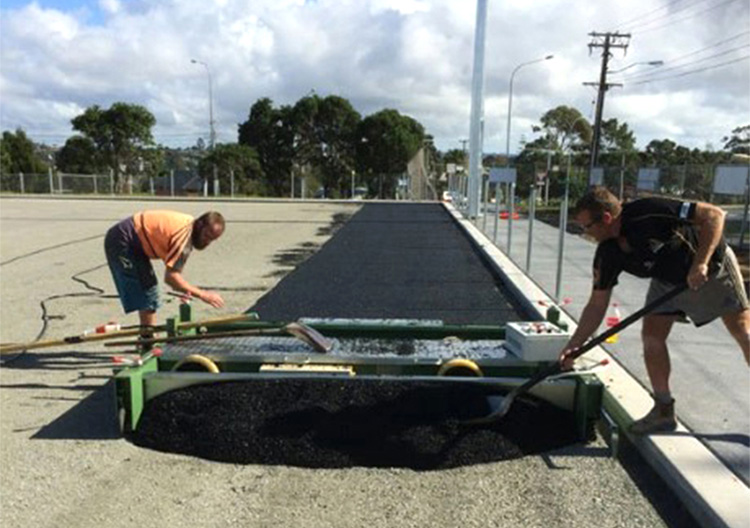Construction Process And Pavement Of Rubber Runway
The construction of the rubber runway is divided into several processes. Only the correct construction of the plastic runway can ensure that the installation of the plastic runway meets the requirements, and the service life of the rubber runway can be extended through reasonable maintenance. In addition to the perfect construction plan, the proportion of raw materials for the rubber runway can be adjusted according to the site site, climate and use requirements, so that the quality of the rubber runway is better and the service life is longer.

General procedures for the construction of rubber runways
1. Remove the rubbish in the site, clean up the accumulated water, and dry it, blow the dust in the site with a hair dryer; clean up the ingredients and mixing site, and keep the area around the glue on the site clean.
2. Use a wire brush to clean the mud spots and white gray spots in the site.
3. Use a hammer and a drill to remove the white ash, cement, and raised parts that cannot be brushed off, and then sweep the entire site.
4. Take a small amount of glue, configure it in proportion, and perform a field test. After the experiment, the next process is performed according to the experimental results.
5. The back cover of the foundation shall be used to level the material of the stagnant water. Seal the place where the compactness is unsatisfactory with glue.

6. Adjust the scale of the rubber paver as required, and then carry out the paving construction. The thickness of each place should meet the design requirements.
7. After the base course has been hardened, drain the water to find the stagnant point, and level the stagnant place until there is no stagnant in the primer. After the primer is completely hardened, the surface of the primer is polished with a sander to meet the requirements of flatness, and then the surface is non-slip sprayed.
8. According to drawings and design requirements, mark various line positions in the site
Matters needing attention in paving rubber runways
Construction requirements for rubber runway pavement
1. Polyurethane plastic materials are most afraid of water during the construction process. A large bubble will be generated when a drop of water is encountered when the glue is initially cured. Therefore, the construction staff must prepare a towel to wipe sweat under high temperature conditions. Be sure to grasp the weather conditions and make emergency measures to prevent sudden showers. Laying time should be avoided in the morning and when the ground is relatively humid. Even on a normal working day when the weather is clear, it is generally best to formally lay the plastic track after 9 am.
2. The solid thickness of the rubber surface refers to the center of the rubber particles from the rubber bottom to the surface, which is generally controlled from two aspects. First, the thickness of the base is pre-inspected through the vertical mold, and the base is partially cut or hammered to ram down. If the height is not much, you can use a flat scraper to add a clamp to remove the mold to ensure the thickness.
3. Prevent local foaming and shelling after the rubber surface is paved. The compactness of the base layer must be strictly controlled to prevent the asphalt base layer from being embedded and imperfect. Pulled off. Where the compactness of the grassroots is not enough, you can use a drill to drill holes and glue (rubber nails) to strengthen it.
4. In order to ensure the flatness and slope, after the nail strips are nailed, use a spirit level to simulate the correction. The individual high places should be leveled first, and the individual low places should be filled with glue.
5. The foundation parts contaminated and corroded by diesel must be dug out firmly and filled with glue.
Baseline requirements for rubber runway pavement
The construction of rubber runways is based on asphalt or cement, and the basic approach is basically the same as road construction. The flatness of the foundation surface is required to ensure that the thickness of the rubber surface layer is uniform and the elasticity is uniform. The quality requirements of the foundation are as follows:
1. Slope: horizontal <1% (curved 8 ‰, straight 5 ‰, semi-circular area 5 ‰), longitudinal <1 ‰, high jump area <0.4%, the surface should be flat and smooth, drainage smooth.
2. Flatness: The qualified rate of flatness is above 95%, and the ruler error of 3 meters is 3mm.
3. Positioning: For accurate construction and line drawing needs, firm and distinctive markers should be used to mark the four semicircle tangent points and the two center points of the runway site.
4. Drainage: The drainage system must discharge standing water two hours after heavy rain. In frozen areas, it is best to add a geotextile buffer layer between the asphalt layer and the gravel layer. The foundation along the drainage channel should be specially waterproofed.
5, strength and stability: the foundation should have a certain strength and stability, the surface is uniform and solid, no cracks, no rotten edges, the seams are straight and smooth. The pads are compact, and the compactness is greater than 95%. After being pressed by a medium-sized roller, there are no significant wheel marks, loose soil, and waves.